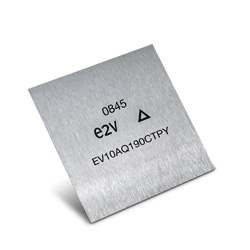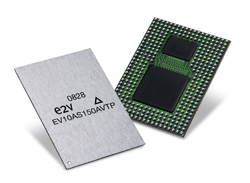New developments enhance both the T&M industry and scientific markets
BY NICOLAS CHANTIER
e2v technologies, Chelmsford, U.K.
http://www.e2v.com
The gigasample-per-second (GSPS) data converter market has been a niche market that is now growing in size due to the combined effect of (1) fair supplier’s competition, which fuels a continuous flow of new-product releases and (2) an increasing number of system designs using data converters sampling at speeds in the GSPS range and beyond.

T&M
There used to be a time when the test & measurement (T&M) data converter market segment was driven by a few oscilloscope manufacturers and the Western world’s military industry. Today, the historical users of GSPS data converters still remain, but the club has grown with new users.
A multitude of new names in the T&M industry in the Asia Pacific region, designers of radio-astronomy systems, designers of high-channel count scientific systems — such as particle physics detection and measurement systems — and designers of point-to-point microwave communication systems. High-accuracy pulsed laser measurement systems, mass spectrometers, HDD testers, and a variety of specialized testers are turning toward GSPS data converters for reasons of speed, accuracy achieved through high-speed sampling, input bandwidth beyond the gigahertz range, or a combination of the three.
In the T&M industry — until just a few years ago — only a few major players had the technical and financial capability to design custom data-conversion ASICs. Today, there are still only a few companies that can afford the process themselves. What has changed is the growing number of standard data converters with sampling frequencies in the GSPS range which now allow both the historical players and the new-comers to design oscilloscopes — or other T&M devices — without taking the risks, bearing the expenses or facing the technical challenge of designing a GSPS data conversion ASICs.
It is important to look at the oscilloscope market for which the GSPS data converters are key components. As this trend in data converters was taking shape, a number of T& M players have emerged and grown, particularly in Asia. These companies are now able to offer either their own brand or OEM oscilloscopes that continuously improve along with the growing list of new GSPS data converters. These converters always break new barriers in sampling speeds, input bandwidths, number of channels and additional built-in features.
For the high-speed data converters industry, this trend creates ground for growth, and for the T&M industry, it means that technological barriers for new entrants in the market are moving and becoming easier to overcome as far as components’ availability is concerned.
Military and space
The military and space industries tend to favor high-speed ADCs reaching high-sampling frequencies beyond GSPS, using a single-core architecture and no hidden internal interleaving. It is known that interleaving ADC cores in systems that are subject to wide temperature swings requires temperature monitoring and management of calibration and re-calibration each time the system is subject to significant temperature changes (see Ref 1). Therefore, data converters that achieve GSPS sampling rates with a single high-speed core and thus without using any interleaving techniques show nominal performance across their full temperature range without having to manage calibrations and without using FPGA processing power to remove interleaving spurs in the digital domain.
The contract awarded by the European Space Agency to e2v technologies to develop a 10-bit 1.5 GSPS (see Ref 2) will result in a data converter specifically designed to meet the requirements of the space industry and will indeed reach 1.5 GSPS without any internal interleaving and still meet low-power requirements.
The military industry welcomes both high-input frequencies and high-sampling rates without internal interleaving for the same reasons of performance across temperature range explained above. They are users of devices such AT84AS004, EV10AS150 and similar devices.
The GSPS data conversion industry is an area where CMOS and bipolar technologies still compete to some extent. The recent designs from e2v on both Infineon B7HF200 full bipolar process and Jazz Semiconductor high-speed BiCMOS processes achieve power consumption levels that are comparable to CMOS GSPS data converters, but with higher input bandwidths typical of fast bipolar technologies. Reduced supply current transients — such as with e2v’s EV10AQ190 and ADC cores — which can sample signals as fast as 2.5 GSPS without the use of any form of internal interleaving (such as e2v’s EV10AS150). On the other side, CMOS devices typically have a power consumption that is proportional to the sampling frequency and thus the nominal power consumption is reduced in applications where the ADC clock can be slowed down.
10-bit GSPS ADC-overview
10-bit GSPS ADC Typical Power consumption overview. Source : Suppliers datasheets published on their respective Web sites.
10-bit ADCs:
• EV10AQ190 Quad 10-bit 1.25-GSPS device from e2v technologies. BiCMOS process technology from Jazz Semiconductor; power consumption per channel sampling at 1.25 GSPS: 1.4 W /channel at 1.25 GSPS.
• ADC10D1000 dual 10-bit 1-GSPS ADC from National Semiconductor. Supplier’s own CMOS Process technology; power consumption per channel sampling at 1 GSPS: 2.77 W in total for 2 channels enabled or 1.61 W for single channel enabled.
For the foreseeable future, the choice of standard GSPS ADCs will continue to increase with a combination of additional integrated features, higher sampling rates and higher input bandwidths accommodating input signals frequencies well into the S-Band.

Challenges
The next technological challenges may arise in the components surrounding the ADCs. For example, with clock generators and clock management devices — for which jitter performance requirements will become more and more stringent — sampling rates, input frequencies and resolution all tend to increase.
Also, despite an exciting performance competition between today’s best amplifier manufacturers, high-speed differential amplifiers are already a limiting factor in terms of bandwidths, especially with system resolutions of 10 bits designed to digitize signals frequencies in the L-band and beyond. In these applications, only balun transformers provide the appropriate ADC input driver performance. Unfortunately, dc coupling is not possible when transformers are used as differential ADC input drivers. So, as of today, designers of high-speed and high-frequency data conversion systems need to make a choice for each channel between dc coupling but with limited bandwidths — typically up to 1 GHz, depending on the chosen amplifier and its operating conditions — and high input frequencies (but only in ac-coupling mode).
Typically, high-speed amplifiers demonstrate best harmonic-distorsion performance versus frequency with reduced output voltage swings (see Ref. 3). Thus, applications that require dc coupling at the highest possible input frequency will benefit from selecting an ADC with reduced input-voltage range, since this will translate directly into a reduced output voltage swings for the differential amplifiers.
There is such a choice to be made in the case of 12-bit 500-MSPS ADCs:
Input-voltage range of typical 12-bit 500-MSPS ADCs. Source: Suppliers datasheets published on their respective Web sites
E2v AT84AS001: 1.1-Vp-p input voltage range.
Intersil KAD5512: 1.47-Vp-p input voltage range.
Texas Instruments ADS5463: 2.2-Vp-p input voltage range.
Concerning FPGAs in high-speed data conversion systems, the trend to increase FPGA I/O speeds will allow the elimination of ADC output demultiplexers on multichannel ADCs such as the EV10AQ190 quad 10-bit 1.25-GSPS ADC. This makes it possible to maximize the number of channels being processed per FPGA for any given number of available FPGA I/Os.
References
1. Datasheet of National Semiconductor ADC08D1000 Section2.4.2.2. about On-Command calibration, http://www.national.com/pf/AD/ADC08D1000.html#Datasheet.
2. ESA AMICSA 2008 Conference Proceedings – e2v presentation : http://www.congrex.nl/08c21/AMICSA2008_Abstracts.zip
3. Analog Devices AD8352 amplifier datasheet — figure 12 « Third-order harmonic distortion (HD3) versus Frequency http://www.alldatasheet.com/datasheet-pdf/pdf/166108/AD/AD8352-EVAL.html. ■
Advertisement
Learn more about e2v technologies





